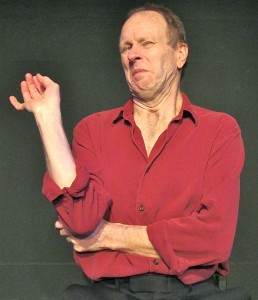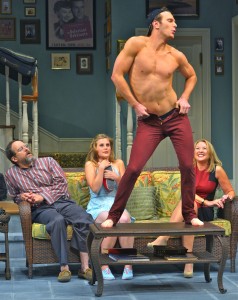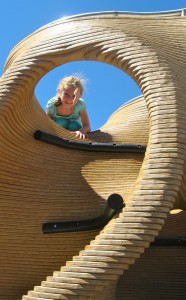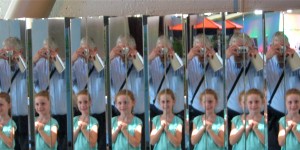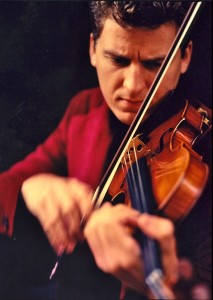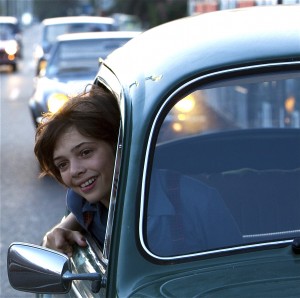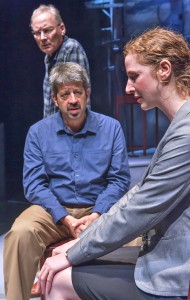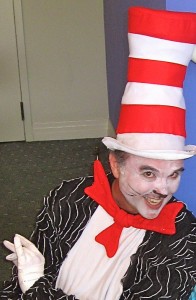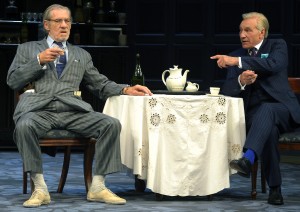Woody’s [rating:2.5]
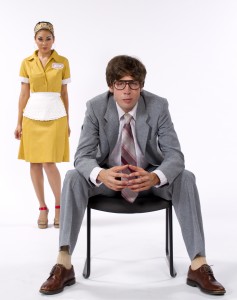
Jeremy Kahn and Rinabeth Apostol are counterpoints as Bill Gates and Luz Ruiz in “First.” Photo: Kent Taylor.
“First” is a fictional glimpse into the future of today from the yesterday of 1976.
It’s an episodic feast of words and ideas — for geeks, freaks, nerds and eggheads. Or recovering or aging geeks, freaks, nerds and eggheads.For others not obsessed with computers, not so much.
Count me in the latter list.
Why? Because the 105-minute play’s excessively crammed with factoids and history and real icons of the computer and software universe that may make delicious provender for techies but overpower folks like me.
I remember having a friend in the early ‘80s who swore by The Well, a social networking site where co-owner and “First” playwright Evelyn Jean Pine first experienced this ‘n’ that.
My gal-pal constantly regaled me with stories of bulletin boards and other now-obsolete niceties — niceties I couldn’t grok (or sometimes even pronounce properly).
I remember that she’d tell me of the hours and hours she’d spent on this game or that, on locating this obscure piece of trivia or that.
And I recall endlessly discussing such nonsense like whether online should be spelled on-line or OnLine instead.
Mostly, I couldn’t get excited. Then.
But I got hooked on the software and hardware like everyone else (just as Bill Gates and his Microsoft co-founder, Paul Allen, and a handful of other technology prophets had predicted).
“First,” which was commissioned and developed by PlayGround and which will play in the tiny Theatre Werx space through Nov. 3, details the origins of the digital revolution.
With drama. And humor.Exactly how much is accurate, how much exaggerated, I can’t say.
But I can say that it’s interesting.
And entertaining.
And amusing.
And that all six actors are competent at worst, excellent at best. The latter category includes Jeremy Kahn as a 20-year-old Gates, a mono-focused, egocentric boy wonder, and Rinabeth Apostol as Luz Ruiz, ex-pot dealer waitress.
Ruiz, the only grounded character, acts as a significant counterpoint to the head-in-the-clouds, persona non grata Gates.Instead of perceiving him as a future-seeking marvel, she sees him as “the kid doing wheelies in the parking lot this morning.”
She speaks in English, he in gobbledygook.
Except for a telling moment when he seriously advises her, “People let you do anything — if you push hard enough.”
The catch-all scene is the first personal computer conference.
There, Gates, a Harvard absentee, faces Ed Roberts (David Cramer) — a real-life guy who manufactured the first commercially successful PC kit, the $397 Altair.
He faces, too, a horde of customers irate because he’s demanding they stop sharing software.
Gates reads hate mail; the throng he perceives is “robbing him blind” boos; and Roberts (“I didn’t know I was inventing the future”) futilely urges him to apologize to the crowd.
Michael French directed this world premiere, and does well for the most part.
He does stumble into opaqueness a couple of times, however — when staging a game of keep-away with a Basic code disc, for example, and when IBM marketer Kevin Panik (Tim Green) does an awkward striptease.It’s also problematic trying to define a flighty character, Georgia Potts (Brandice Marie Thompson), self-taught programmer and computer addict who’s drawn to Valentine Smith (Gregory W. Knotts), visionary-dreamer-philosopher who renamed himself for a character in a sci-fi novel, “Stranger in a Strange Land,” a title that doubles as a “First” theme.
Without the humor or the Ruiz character, this would be a mediocre portrait but plot-less play. With them, it’s notable.
The real Gates might be pleased with his visage here, but he most likely hates that his love-child company may be following the path of IBM into irrelevancy.
And he’d definitely despise that I’m writing this review on an iMac.
“First” runs at Stage Werx, 446 Valencia St., between 15th and Sparrow streets, San Francisco, through Nov. 3. Night performances, 8 p.m. Thursdays through Saturdays; matinees, 2 p.m. Sundays. Tickets: $25 to $35. Information: (415) 992-6677 or www.playground-sf.org.


